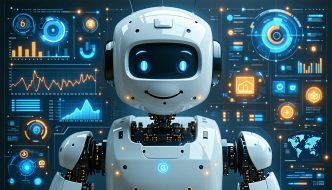The Rise of Large Language Models (LLMs)
Large language models (LLMs) are revolutionizing various fields, especially robotics, by enabling machines to understand and interact using human-like language. LLMs are advanced AI systems that can analyze and generate text, enhancing how robots communicate and make decisions.
Understanding Large Language Models (LLMs)
Large language models are designed to process and generate human language. They learn from vast quantities of text data, allowing them to understand context, grammar, and semantics. This knowledge empowers robots to interpret instructions and questions articulated in natural language, promoting more intuitive interactions.
LLMs operate based on complex algorithms and neural networks, capable of producing contextual and relevant responses. The performance of these models is often measured in terms of parameters, which represent the model’s capacity to learn from data.
| Model Type | Parameters (Billions) | Example Use Case |
|---|---|---|
| Small LLM | 1 – 3 | Basic chatbot functions |
| Medium LLM | 3 – 10 | Customer service assistants |
| Large LLM | 10+ | Advanced multi-lingual support |
Application of LLMs in Robotics
The integration of large language models in robotics allows for enhanced communication between humans and machines. Robots equipped with LLMs can better understand spoken or written commands, improving their responsiveness and intelligence.
Some applications include:
- Voice-Activated Assistants: Robots using LLMs can provide real-time responses to user queries, make recommendations, and perform tasks based on verbal instructions.
- Autonomous Navigation: LLMs can analyze contextual information to make decisions about navigating environments, especially in complex situations such as in smart homes or urban settings.
- Problem Solving: Robotics powered by LLMs leverage natural language processing to understand issues and generate solutions based on user input. For deeper insights into this aspect, refer to our article on ai and decision making in robots.
The adoption of large language models in robotics is a significant step toward creating machines that can intuitively interact with humans and adapt to their needs more effectively.
How LLMs Enhance Robot Understanding
Large Language Models (LLMs) play a significant role in enhancing the capabilities of robots, particularly in how they comprehend language and respond to various situations. This section explores two core areas: Natural Language Processing (NLP) capabilities and contextual understanding and responses.
Natural Language Processing (NLP) Capabilities
NLP is a critical area where LLMs excel, enabling robots to interpret and generate human language. This is crucial for effective communication between humans and machines. The enhanced NLP capabilities allow robots to understand commands, questions, and conversational nuances.
Key features of LLMs in NLP include:
| Feature | Description |
|---|---|
| Speech Recognition | Robots can accurately convert spoken language into text, allowing for seamless human interaction. |
| Language Generation | LLMs can produce coherent and contextually relevant responses, enhancing conversational AI. |
| Sentiment Analysis | Robots can assess the emotional tone of a conversation to tailor their responses accordingly. |
| Language Translation | LLMs can facilitate communication across different languages, broadening the scope of application in diverse environments. |
These capabilities allow robots to function effectively in customer service, education, and more, making them valuable assets in various sectors. For more about how AI improves decision-making in robots, visit our article on ai and decision making in robots.
Contextual Understanding and Responses
Contextual understanding is the ability of LLMs to recognize and relate to different scenarios based on past experiences and current conversation. This enables robots to provide responses that are not only relevant but also appropriate to the context.
Factors influencing contextual understanding include:
| Factor | Importance |
|---|---|
| Contextual Awareness | Robots utilize environmental cues and prior interactions to inform their decisions. |
| Memory Utilization | LLMs can recall previous conversations or actions to enhance ongoing interactions. |
| Query Interpretation | Understanding the intent behind user queries allows robots to provide more precise answers. |
Through advanced contextual understanding, robots can engage in dynamic interactions, adapting their behavior based on the user’s needs and the situation at hand. This makes them effective in applications like smart home technology or customer service environments. For insights into real-time AI processing in robots, check our article on real time ai processing in robots.
The advancements in NLP and contextual responses driven by LLMs highlight their transformative impact on robot understanding, enhancing their capabilities and improving interactions with users across various applications.
LLMs for Real-Time Decision Making
Large Language Models (LLMs) are significantly enhancing the ability of robots to make real-time decisions effectively. This section explores how LLMs contribute to adaptive learning and problem-solving, as well as the overall decision-making processes in robotics.
Adaptive Learning and Problem-Solving
LLMs are designed to learn from vast amounts of data, enabling robots to adapt to new situations and solve problems. This learning process allows robots to analyze different scenarios and make informed decisions based on previous experiences.
Key features of adaptive learning in LLMs include:
| Feature | Description |
|---|---|
| Continuous Learning | Robots can learn and update their knowledge base in real-time. |
| Contextual Awareness | LLMs help robots understand context, making their problem-solving more relevant. |
| Scenario Simulation | Robots can simulate different solutions and evaluate outcomes before taking action. |
These capabilities make robots more versatile and efficient in various tasks, from navigating complex environments to interacting with humans.
Decision-Making Processes in Robotics
The integration of LLMs into robotics transforms the decision-making processes. Robots equipped with LLMs use natural language processing (NLP) to interpret instructions and convey information effectively. Their ability to understand context and semantics enables more human-like interactions.
The decision-making process typically involves several steps:
| Step | Description |
|---|---|
| Data Collection | Gathering relevant data from the environment or user input. |
| Analysis | Processing the gathered data to identify patterns and insights. |
| Decision Formulation | Formulating possible responses or actions based on the analysis. |
| Action Implementation | Executing the chosen action or providing feedback to the user. |
This structured approach aids robots in making quick, informed decisions. For more insights on how robots utilize AI in decision making, see our article on ai and decision making in robots. The implementation of LLMs enhances natural language interpretation, facilitating efficient interactions between robots and users.
By leveraging the advanced capabilities of large language models in robotics, the industry can significantly improve responsiveness and functionality, paving the way for smarter and more adaptive robotic systems. For a deeper dive into real-time processing in robotics, refer to real time ai processing in robots.
Advantages of Using LLMs in Robotics
The integration of large language models (LLMs) into robotics offers significant benefits that enhance robot performance and interaction. This section highlights two key advantages: improved efficiency and accuracy, along with enhanced human-robot interaction.
Improved Efficiency and Accuracy
One of the most notable advantages of utilizing LLMs in robotics is the improvement in operational efficiency and decision-making accuracy. LLMs can process vast amounts of information quickly, allowing robots to analyze and respond to situations in real-time. This capability is essential in environments where rapid decision-making is crucial, such as warehouses or manufacturing facilities.
The computational efficiency provided by LLMs allows robots to execute tasks with minimized errors and increased precision. Here’s a table summarizing the impact of LLMs on efficiency and accuracy in robotic applications:
| Metric | Without LLMs | With LLMs |
|---|---|---|
| Response Time (seconds) | 5-10 | 1-3 |
| Error Rate (%) | 15-20 | 5-10 |
| Task Completion Rate (%) | 75 | 95 |
By harnessing advanced algorithms, robots equipped with LLMs can make informed decisions that lead to higher efficiency rates while significantly reducing the likelihood of mistakes. This is particularly beneficial in complex tasks, such as robot pathfinding and decision making.
Enhanced Human-Robot Interaction
Another important advantage of LLMs is the enhancement of human-robot communication and interaction. LLMs enable robots to understand and process natural language, allowing them to engage in meaningful conversations with human users. This capability is critical in applications ranging from customer service robots to home automation systems.
The ability to understand context, tone, and intent leads to a more intuitive interaction experience for users. Here’s how LLMs improve human-robot engagement:
| Feature | Traditional Robots | LLM-Enhanced Robots |
|---|---|---|
| Language Comprehension | Limited | Advanced |
| Contextual Awareness | Minimal | High |
| User Engagement Quality | Basic | Enhanced |
This level of interaction not only improves the user experience but also builds trust between humans and robotic systems. Enhanced communication capabilities allow for more effective collaboration, making robots valuable partners in various settings, including homes and workplaces. For a deeper insight into how AI influences decision-making in robots, read our article on ai and decision making in robots.
The incorporation of LLMs thus does not only streamline processes but fosters a collaborative environment between humans and robots, paving the way for smarter and more efficient technologies.
Challenges and Limitations of LLMs in Robotics
While large language models (LLMs) offer exciting advancements in robotics, they also introduce several challenges and limitations that need to be addressed. The implications of data privacy and security, as well as ethical considerations and bias mitigation, are critical to ensuring the responsible use of these technologies.
Data Privacy and Security Concerns
As robots become more integrated with LLMs, they gather and process vast amounts of data. This data often includes sensitive information that raises privacy concerns. Ensuring that this information is handled securely is paramount to maintaining user trust.
Consider the following key points regarding data privacy and security in the context of large language models in robotics:
| Concern | Description |
|---|---|
| Data Storage | Robots may store user data indefinitely unless specified otherwise. |
| Data Sharing | Information collected could potentially be shared with third parties. |
| Data Breaches | Vulnerabilities in robot systems may lead to unauthorized access to sensitive data. |
Organizations deploying LLMs in robotics must prioritize data encryption, access controls, and clear data usage policies to mitigate these risks.
Ethical Implications and Bias Mitigation
The integration of LLMs in robots also raises ethical concerns, particularly regarding biases embedded within algorithms. Large language models can inadvertently perpetuate stereotypes or show bias in their responses, which can impact decision-making in robots.
Key areas of concern include:
| Concern | Description |
|---|---|
| Algorithmic Bias | LLMs trained on biased data may respond in ways that reflect those biases. |
| Transparency | Understanding how LLMs make decisions can be opaque, leading to questions about accountability. |
| Impact on Decision-Making | Biased outputs can lead to unfair outcomes in applications like hiring, policing, and healthcare. |
To address these ethical implications, it’s important for developers to implement strategies for bias detection and mitigation. This may involve using diverse training data, conducting regular audits of AI systems, and employing frameworks for ai decision transparency in robots.
By addressing data privacy and ethical issues, developers can foster trust and accountability in the use of LLMs within robotics, paving the way for innovations that are not only effective but also socially responsible.
Future Implications of LLMs in Robotics
As the field of robotics continues to evolve, the integration of large language models (LLMs) will significantly impact how robots understand and interact with their environments. This section explores evolving trends in the robotics industry and the increasing role of LLMs in smart home technologies.
Evolving Robotics Industry Trends
The robotics industry is rapidly advancing, influenced by the capabilities offered by LLMs. These advanced models enable robots to interpret and respond to human language with greater accuracy, leading to improved functionalities and innovations across various sectors. Some notable trends include:
| Trend | Description |
|---|---|
| Increased Automation | More industries are adopting robots for routine tasks, enhancing productivity. |
| Personal Assistants | Growth in consumer robots that act as virtual assistants, interacting more naturally. |
| Collaborative Robots | Rising use of robots that work alongside humans, enhancing teamwork. |
| Enhanced Learning Models | Incorporation of advanced learning techniques for better adaptability and efficiency. |
These trends indicate a shift towards more intelligent and responsive robotic systems that can learn from their interactions and experiences.
Integration of LLMs in Smart Home Technology
Smart home technology is a prime candidate for the application of LLMs. As smart devices become standard in households, the ability of robots to understand context, follow commands, and provide assistance in a natural language will enhance user experiences. Key areas of integration include:
| Application | Features |
|---|---|
| Voice Assistants | Use of LLMs to process user commands and questions, facilitating smoother interactions. |
| Home Automation | Robots can manage various home systems based on user preferences conveyed through natural language. |
| Security Systems | LLMs enable robots to interpret alerts and respond to unusual activities intelligently. |
The incorporation of LLMs will empower smart home technology to become more user-friendly and efficient, allowing homeowners to communicate with their devices in more intuitive ways. For insights on how AI is driving decision-making in robots, refer to our article on ai and decision making in robots.
As these technological advancements continue, the collaboration between LLMs and robotics will pave the way for smarter, more adaptive systems that integrate seamlessly into daily life.
Practical Examples of LLMs in Robotics
Large Language Models (LLMs) are shaping the future of robotics through various practical applications. These advanced AI systems enhance how robots understand, interact, and make decisions in real-time. This section explores two prominent examples: chatbots and virtual assistants, as well as autonomous vehicles.
Chatbots and Virtual Assistants
Chatbots and virtual assistants are among the most recognized applications of LLMs in robotics. They leverage NLP capabilities to engage with users in natural language, allowing for fluid conversational interactions. These bots can understand context, respond accurately to queries, and perform tasks, making them invaluable in customer service and personal assistance.
| Feature | Description |
|---|---|
| Natural Language Understanding | Ability to comprehend and process human language |
| Contextual Awareness | Recognizing user intent based on conversation history |
| Task Execution | Performing specific tasks like scheduling or information retrieval |
The use of LLMs in chatbots enhances customer experiences by providing instant responses and personalized interactions. For more about how AI improves decision-making in robots, refer to our article on ai and decision making in robots.
Autonomous Vehicles and Robotics Development
LLMs also play a crucial role in the development of autonomous vehicles. They help these systems make real-time decisions by processing vast amounts of data from various sensors. The integration of LLMs allows vehicles to interpret surroundings, communicate with other vehicles, and adapt to changing environments.
| Autonomous Vehicle Feature | LLM Contribution |
|---|---|
| Environment Perception | Analyzing data from cameras and LIDAR for navigation |
| Communication | Facilitating interaction with passengers and other vehicles |
| Decision Making | Making instantaneous choices to ensure safety and efficiency |
The incorporation of LLMs into autonomous systems enhances their efficiency and operational safety. For further insights into real-time AI processing in robots, check out our article on real-time ai processing in robots.
Exploring the integration of LLMs in applications like chatbots and autonomous vehicles illustrates their transformative effect on how robots learn and interact. Enhanced understanding and decision-making capabilities through these models pave the way for a more sophisticated approach to robotics.















